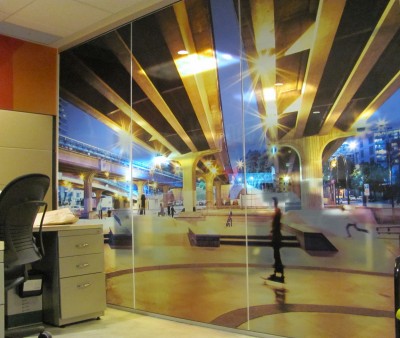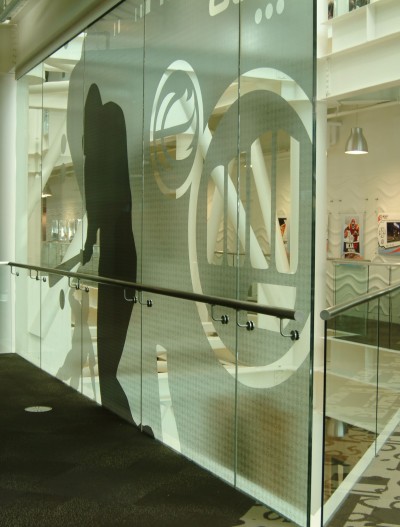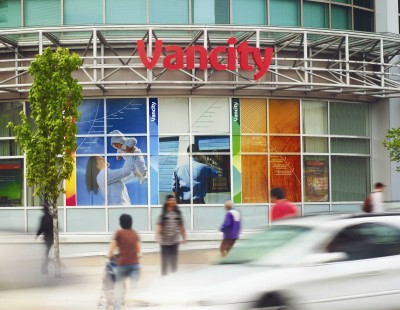Next, 3M Canada’s Clear View, a highly transparent window film, was treated with Stockhouse’s Pantone orange brand colour—using a Vutek UltraVu 3360 super-wide-format digital printer—and applied to the meeting room window. This helped provide privacy for groups using the space, while also ensuring a consistent theme throughout the offices. Although the film is hard-wearing, one key benefit of installing it is it can be easily removed later if it is no longer required or if the company decides to change its colour scheme.
The colour scheme adopted for the entrance differed from that in the office area, where a 508-mm (20-in.) wide ‘ticker tape’ graphic was applied across the ceiling and onto a far window’s glass panel. It too was printed using the UltraVU 3360, but onto 3M’s ControlTac 0.05-mm (2-mil) thick cast vinyl with Comply adhesive, then treated with a gloss laminate. The graphic’s letters were produced separately with Duratext vinyl, as were silver stripes for either side of the graphic.
By using this combination of wall and window treatments, Stockhouse’s new interior design scheme can better communicate the company’s brand in an open and warm way, enhancing a space that was previously unremarkable. The rooms even feel larger now that they are visually connected, with common colours tying them together.

This Vancouver-based call centre used graphics to enhance a space and provide an added sense of depth. The project also masked a partition wall.
Wall murals
Ampco Grafix recently themed its own lunchroom with a wall treatment, but in a very different way. The large-scale graphic depicts a scenic waterfall as a background image and showcases inspirational testimonials from the company’s customers in the foreground, using vinyl lettering. This personal touch makes lunch more enjoyable for staff than staring at a blank wall would be.
Indeed, an interior space—large or small—can be visually enhanced with wall murals to add interest, colour and even a greater sense of height and depth through optical illusions. By injecting personality into a tired, uninspiring space, a mural is an instant eye-catcher that can take a room from bland to spectacular.
Printed onto wall-graphic substrates and complemented by architectural finishes, wall murals can feature intricate and dramatic design schemes. Ampco Grafix recently transformed the entrance to a ColyVan Pacific apartment complex in North Vancouver using mural graphics and Di-Noc architectural-finish vinyl films with Comply adhesive for a wood effect.
These types of films can help renew a building without costly renovations. They are popular in the construction and interior design communities because they closely approximate the appearance of metallic or natural materials, like wood and stone, but at a lower cost. They are also perceived as a ‘green’ alternative to using natural resources.
The apartment complex’s scenic wall mural, meanwhile, helped make a dull and uninspiring space warm, open and inviting. It also gave a narrow corridor a greater sense of depth.
Michael A. Craig & Associates, a design firm in North Vancouver, recently worked with Ampco to enhance the interior of Palki Restaurant, also in North Vancouver, with bold, stylish and colourful wall graphics. The UltraVu 3360 was used to print the graphics on ControlTac vinyl and then they were matte-laminated.

Some window films are designed to replicate the appearance of etched, cut, frosted, sandblasted or textured glass.
Window options
In some buildings, companies use windows as a canvas because they want to mask unsightly and/or distracting views. A long wall with several windows can even be covered entirely with a single treatment, rather than wrapping each window individually. The effect could make the wall appear larger.
Such was the case for a Vancouver-based call centre, which used graphics to enhance a space and provide an added sense of depth. The project also masked a partition wall.
Other reasons to apply graphic panels to windows include controlling how much light enters throughout the work day and preventing outsiders looking in with a partial or complete ‘privacy screen.’ With gradation effects, it is even possible to tailor the amount of transparency along different parts of a window’s surface, which can help naturally light a room without letting direct glare affect staff.
Of course, window treatments are also an easy way to add a splash of colour to a room. They are easily changed out to serve as seasonal décor or simply to change the ‘mood’ of the room.
There are a wide variety of window films available today to achieve different effects. Some are optimized for printing graphic elements. Others are designed specifically to block ultraviolet (UV) rays or ensure privacy. Still others are decorative film finishes, with patterns that capture the look of etched, cut, frosted, sandblasted or textured glass to a realistic degree, but at a fraction of the price. 3M’s Fasara products are examples of this type of film.

Durable materials can be installed on the outside surfaces of a building’s windows, but it is often easier to apply graphics on the interior surfaces instead.
In some cases, full-colour graphics are printed onto a transparent film, so as to divide spaces with images while still letting people see out. This is one of the best ways to make a confined space feel open and larger than it actually is.
Durable, weather-resistant materials can be installed on the outside surfaces of a building’s windows, but it is often easier to apply graphics on the interior surfaces, whether using full-colour panels, transparent films, die-cut or computer-cut graphics, double-sided films or perforated vinyl. Films intended for backlit signage can work well, given they will be lit naturally by sunlight outside and office lighting inside.
There are even methods for printing graphics directly onto smooth glass before windows are installed. These tend to be for more permanent architectural purposes.
The process and material of choice will depend on the client’s needs. The possibilities are nearly endless today for enhancing, dividing or unifying spaces with graphics, but what specifically can be printed and installed will correspond to what the customer is looking for.
In any case, it is a good idea to consider window coverings as early as possible in the initial planning stages for any interior design project, particularly in open-concept spaces. The average building has more than 20 windows, all of which are potentially a canvas for graphics!
Jane Rogers is a marketing support specialist for Ampco Grafix, a division of Ampco Manufacturers in Coquitlam, B.C. For more information, visit www.ampcografix.com.





